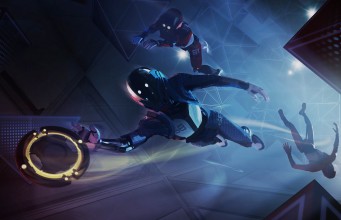
Flying through an obstacle-filled arena in zero gravity like in the Battle Room scenes of Ender’s Game, catching and throwing a disk to score in an opposing team’s goal, all while in a Tron-looking virtual reality, is probably about the best way I can describe Lone Echo’s surprisingly successful multiplayer mode in one sentence.
At Oculus Connect 3, I was able to try a singleplayer demo of Lone Echo, an Oculus Touch exclusive by developer Ready at Dawn that lets you grab, pull, and push yourself around in zero gravity as a robot, but I didn’t know what to expect when I was told that I’d get to try out a multiplayer demo as well, since the singleplayer didn’t really have any activities that I could imagine doing with someone else in a meaningful way, much less in a competitively.
Nonetheless, while it didn’t seem to have anything to do with the single player, aside from the robot you inhabit in both modes, and the zero-g movement style, it was a very different and fresh taste of what could be done with zero gravity sporting in VR. From the outside, this floating, zero-g movement seems like a prime candidate for causing nausea in VR, and yet it managed to be an incredibly effective way of getting around that didn’t seem to cause me or other people I played with any dizziness.
I played in a match of five vs. five. Our team captain—a real person playing in another room—taught us not only how to play the game, but also how to navigate in the 3D, zerg-g arena. We would move around in zero gravity either with thrusters, or by grabbing, pulling, or pushing ourselves on our way with the help of walls or floating geometry (or even teammates or enemy characters). We’d be vying for a glowing disc in the middle of the Ender’s Game Battle Room-style arena (though it wasn’t nearly as big). Then we’d have to grab the disc and throw it into the holographic goal at the end of other team’s side.

A final piece of the puzzle was a punch you could do only to opponents’ heads to briefly stun them, preventing them from being able to move and hold the disc. You could also grab and climb onto bodies, so a common maneuver would be to grab onto a limb, clambor up, punch them in the face, and snatch the disk right from their hands, then give yourself a shove off of their stunned body to head toward the goal.
It sounds simple enough, but the mechanics seem like they could allow complex strategy as you might expect in a real sport. Of course, there was nothing to enforce any ‘rules’ or positions (like a goalie or reciever), but smart players would naturally fall into such roles to beat the opposing team (who were most likely playing the game for the first time and didn’t have any strategies other than to all flock for the disc like it was second grade soccer at recess).
Speaking of soccer, passing is a huge part of the game, especially when your teammates are careening across the area in zero-g. It’s fun not only to be the thrower, needing to skillfully lead the disk to where your teammate is headed on their trajectory, but equally as much to be the receiver who has to launch themselves in the right direction at the right time to intercept the disk. More advanced players will see opportunities for bouncing the disc off the arena’s angular walls to send it around opponents land it in a key position in front of the opposing goal.
You can defend the goal, and (in the demo version we were playing) you might be really good at end the game there because the other team couldn’t organize well enough in the short time frame of the demo to score. My time playing Lone Echo’s multiplayer was a fun, heated battle for the disc, that didn’t leave me nauseous despite flying around in every which direction unhindered by gravity.
Every direction indeed; while playing the demo I was constantly spinning around in real life, reaching out with my touch controllers to try to grab a passing disc or tossing it to a teammate while shoving off of a wall to avoid an enemy. Based on what I saw, the game will almost certainly require the two-camera ‘opposing’ setup for the Rift (cameras opposite each other), or the three-camera setup for full 360 coverage. Otherwise it seems like it would be extremely difficult to keep yourself facing forward for the two-camera ‘front-facing’ setup (as you’d lose tracking on your hands regularly when turned away from the cameras).
Lone Echo’s surprisingly successful multiplayer feels like it could be a major addition to the game. Despite not yet having an official released date, what I played seemed very polished and fun already, with huge potential to become something even greater than what we’ve seen from the still burgeoning VR e-sports sector.
The post Hands-on: ‘Lone Echo’ Multiplayer is a Totally Surprising Triumph for Competitive Zero-G Locomotion appeared first on Road to VR.
Source: Hands-on: ‘Lone Echo’ Multiplayer is a Totally Surprising Triumph for Competitive Zero-G Locomotion






